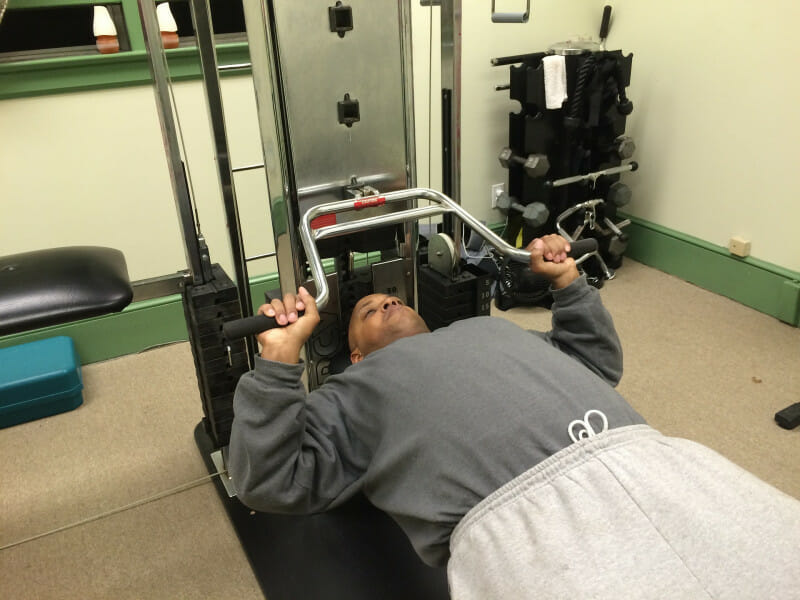The Decline Bench Press Targets Hard-To-Reach Muscles for Better Posture and Functional Movement
The decline bench press doesn’t get nearly enough love. And trainers say it’s about time you put it to work in your exercise routine.
While the flat bench press is perfectly level to the ground and the incline bench press is at an upward slope, the decline bench press offers more of a challenge. “It positions you at a downward slope in order to target a different area of your chest—your lower pecs—than a flat or incline bench,” says Emily Hutchins, a certified personal trainer with RSP Nutrition. Since you’re working against gravity and pushing the weight up from a downward angle, you’re able to hit those hard-to-target muscles.
“It positions you at a downward slope in order to target a different area of your chest—your lower pecs—than a flat or incline bench.” —Emily Hutchins, personal trainer”
Building up every area of your chest—including the lower pecs, as this piece of equipment does—can benefit you greatly in your everyday life. “Having strong chest muscles helps facilitate posture and assists in everyday movements, such as flexion, adduction, and the international rotation of the humerus,” she says. In addition to strengthening your chest, the decline bench press also builds up your arms and shoulders—particularly your anterior deltoids, triceps, and biceps. Here’s exactly how to go about using a decline bench press for yourself.
How to use a decline bench press
If you want to try the decline bench press for yourself, you can use Hutchins’ easy-to-follow instructions. They’ll ensure you’re not only getting the most out of it, but also doing everything correctly.
- Keeping your abs engaged, lie back on a decline bench.
- Hold a pair of dumbbells (start with a lighter weight and gradually increase it over time) at the sides of your your chest. Your palms should be facing forward. Or, if you’re using a barbell, grip the bar palms-forward with your arms slightly wider than shoulder-width apart.
- Push the dumbbells or bar up over your chest.
- Pause, and then slowly lower back down to your starting position.
If you’re a beginner, Hutchins says to start with a weight you can easily press for 10 reps. “From there I’d suggest a 5 to 10-pound increase—and no more than 10. Otherwise, you’re setting yourself up for an injury.
Helpful tips you should know about decline bench press
There are a few things Hutchins says to keep in mind when you’re using this piece of equipment.
1. Avoid starting too heavy
It’s tempting to want to challenge yourself right away, but that’s never a good idea. “Avoid starting too heavy,” she says. By doing so, you could be taking on too much (and potentially hurting yourself) before you’ve mastered the form and have worked up enough strength. Instead, start at a manageable weight and go from there.
2. Avoid holding your breath
How often do you catch yourself holding your breath when you’re doing a challenging exercise? Hutchins says it’s a common mistake people make when using a challenging piece of equipment like this. When you keep breathing, you’ll have better form, will be more stable, and perform better overall.
3. Avoid your elbows being too wide
Another common mistake Hutchins sees is people’s elbows being too wide. “Try to keep them at 45 degrees from your body,” she says. When you keep the correct form, you’ll keep your body feeling its best and get more out of the exercise.
The pros and cons of using a decline bench press
Using the decline bench press has plenty of pros. “It targets different areas of the chest that flat and incline benches don’t,” Hutchins says. “It also puts less stress on your shoulders, allows for a greater range of motion, and allows you to press more weight.” With that being said, there are also some negatives.
First of all, it isn’t always an option at the gym. You’ll see regular bench presses much more often than a decline option. Luckily, there’s a workaround: You can buy an adjustable bench ($190) to use at home in multiple positions. Another con is in your grip when using a barbell. “If your grip isn’t in the right place, it could impinge the shoulder,” she says. Always make sure you’re gripping the bar with your arms slightly wider than shoulder-width apart. Other than that, you can’t go wrong with this challenging and effective piece of equipment.














